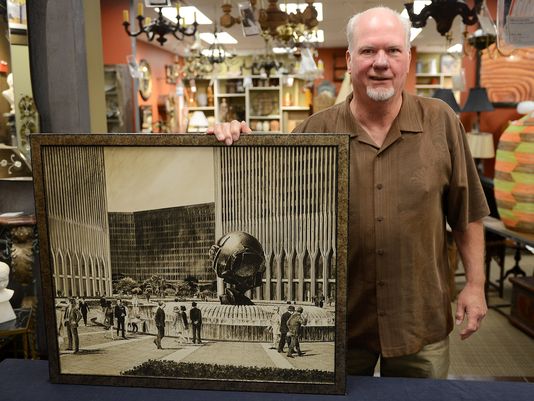By Khristi Zimmeth The Detroit News

Dan McGraw of Clarkston with his World Trade Center artwork. Photo: Robin Buckson, The Detroit News
From 1994 through 2008, Dan McGraw of Clarkston owned a framing store in downtown Rochester. Among his customers, he told Trash or Treasure in a letter, was the renowned architectural firm Yamasaki and Associates, well known for work on New York’s World Trade Center.
“I did various framing services for them and dry mounting of drawings,” McGraw remembers. “Senior architect Henry Guithard and I became friends and would often talk about the complications of constructing a large project such as the WTC. Henry was devastated by its destruction. Several months after September 11, I asked him if I could have something from the WTC, perhaps a blueprint drawing. A few days later, Henry gave me this beautiful copy of a drawing by Carlos Diniz, which had been given to him by Yamasaki himself.”
The print has at its centerpiece Fritz Koenig’s “The Sphere,” which became recognized as the centerpiece between the World Trade Center’s two towers, according to McGraw, who supplied the following background information.
“Mr. Koenig began his sculpture in 1967 in his barn in Germany after being commissioned by architect Minoru Yamasaki. The piece was completed in 1971. Artist and architectural renderer Carlos Diniz, working with information provided to him by Yamasaki, was able to complete an accurate rendering of the World Trade Center and its centerpiece, ‘The Sphere.’ This was completed in 1968, three years before ‘The Sphere’ itself was completed, two years before ground breaking and six years before occupancy. A copy of the drawing was given to Yami, who framed it in an inexpensive black metal frame with glass and it hung for several years behind his desk. Somehow the glass broke and put a minor puncture in the artwork. The piece was then stored for several years in Yami’s closet.”
That same piece was the one that McGraw brought in to Judy Frankel Antiques in Troy recently for appraisal. Appraiser Brian Thomczek looked at it closely and proclaimed it one of the more unusual items he had seen since beginning work with the column.
“It’s very interesting, especially now that the building is gone,” he told McGraw, who says he’s hesitant to hang it because of exposure to light. He has kept it in a cool, dark place since it was given to him.
“Mr. Diniz died in 2001,” McGraw told Thomczek. In an effort to learn more, McGraw also contacted the artist’s architect son-in-law and the Cella gallery in California, which represents his work, asking if the artist made copies of his work. “Neither was aware that he did,” he told the appraiser. “Mr. Cella confirmed that my copy is the exact size of the original which was marked at $1 million dollars in his gallery,” he continued.
Unfortunately, there’s a huge difference between the value of an original work and a print, says Thomczek, who said that McGraw’s print would probably bring somewhere around $300-$500 at auction if he were to sell it.
“There’s always a possibility it would do better because of local interest or in a sale of architectural works or scientifica, but the fact that it’s just a print holds it back,” according to the appraiser, who consulted a few other experts before delivering his verdict. He added that a museum in Lansing is currently organizing a show of blueprints and other renderings that came from Yamasaki’s local office.
“It’s nice and his solid historical interest, but it’s just not a huge dollar item,” he told McGraw about his item. “Unfortunately in the end it’s just a print. It if were the original, that, obviously, would make a huge difference.”
Do you have an object you would like to know more about? Send a photo and description that includes how you acquired the object to: The Detroit News, Trash or Treasure?, 160 W. Fort St., Detroit, MI 48226. Include your name and daytime telephone number. You may also send your photo and description to trashortreas@aol.com. If chosen, you’ll need to bring the items to an appraisal session. Photos cannot be returned.

